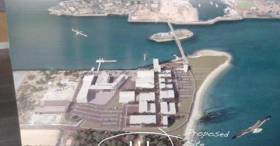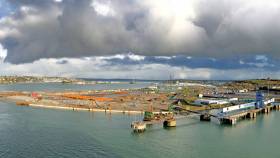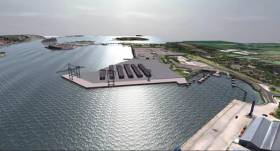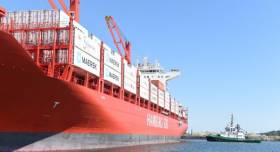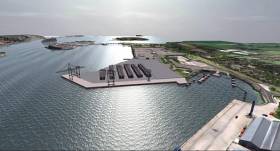Displaying items by tag: Ringaskiddy
Cork Harbour: License Sought for Incinerator Despite Ongoing Court Case Over Planning
A citizen group based in Cork which is against a planned incinerator in Ringaskiddy has criticised Indaver Ireland’s application for an emission licence despite a pending court judgment on the validity of planning permission.
As GreenNews.ie reports, Cork Harbour Alliance for a Safe Environment (CHASE) said that it has been recently informed by Indaver of its plans to proceed with an application to the Environmental Protection Agency (EPA).
“Indaver are obviously presuming that their permission will stand in advance of any High Court decision, which we believe is a premature assumption,” Mary O’Leary, Chairperson of CHASE said.
Ms O’Leary reiterated the group’s concerns about the health implications of living near an incinerator, reasoning that scientific studies have shown that “particles coming out of incinerators are more toxic than for other combustion processes”.
A new study carried out by Chinese researchers has revealed that fine particles emitting from urban waste-to-energy plants can“contain high amount of toxic compounds and pose a serious threat to environment and human health”.
The High Court commenced hearing the controversial incinerator case earlier in March with no final judgment issued yet.
For further reading on this story click here.
Stowaways From Albania Found in Ringaskiddy Face Deportation
#ferries - Stowaways were found hiding in a container at the Port of Cork’s Ringaskiddy ferry terminal moments after it arrived off a ship from Spain.
The eight, according to the Irish Examiner, were all Albanian nationals under the age of 24, including a 16-year-old , were found hiding between pallets in a container on the back of a truck which had disembarked the ferry from Santander in northern Spain around 5pm on Monday.
It is the second time in four weeks that stowaways have been found using the same service. Four were found in a container at Santander port earlier this month before the lorry boarded the vessel.
While the crossing takes more than 26 hours, it is understood the men could have been in the container for up to four days. There were signs that they had access to food and water during the crossing. The container was soiled by excrement.
Gardaí and paramedics were alerted and the men were medically assessed. All were in relatively good physical condition but one was treated for mild dehydration. The seven adults were taken into custody by garda immigration officers. Four have since been deported, three remain in custody pending deportation, and the youth is in care pending further enquiries.
A garda spokesman said there is an immigration presence at all arrivals into the State.
The newspaper has more on the story here.
Work Begins On New Cork Container Terminal
Maritime Journal reports that work has begun on the Port of Cork’s new Cork Container Terminal at Ringaskiddy.
Afloat.ie previously covered the development at its launch last June, where plans were revealed for its first phase of a 300-metre quay with 13-metre depth that will enable larger container ships to berth adjacent to Ringaskiddy’s existing RO-RO ferry terminal.
The €80 million project will also see construction of a 13.5 hectare terminal and associated buildings, plus two ship-to-shore gantry cranes and container handling facilities.
BAM Civil Ltd won the tender for the Cork Harbour development and commenced work on the site in late 2018, following a hiccup involving a reported ‘mistake’ in the tender sums.
#PortofCork - No slip ups took place yesterday as the largest container ship to ever berth in the Port of Cork's deepwater terminal unloaded a mega cargo of fruit - including millions of bananas.
The MV Polar Costa Rica, reports the Irish Examiner, measures almost twice the length of Páirc Úi Chaoimh, eased past Roche's Point after its 10-day transatlantic voyage and tied up just after 4pm at the port facility in Ringaskiddy.
A huge logistics operation kicked in to unload part of its massive cargo of bananas predominately, but also pineapples and melons, direct from plantations across Central America.
With a deadweight tonnage of 43,600 tonnes, the 230-metre long ocean-going giant was carrying hundreds of huge containers, each containing several pallets which in turn contained dozens of smaller boxes of fruit.
The capacity of the ship - when measured in bananas - is staggering.
To find out more on the importation of bananas and the other perishable products, click here.
#CorkHarbour - Tánaiste Simon Coveney has echoed the concerns of locals in Ringaskiddy at the news that planning permission has been granted for an incinerator in their area.
RTÉ News reports on An Bord Pleanála’s approval of the €160 million waste-to-energy project, which went against its own inspector’s recommendation.
The decision was made after a lengthy series of deferrals, the most recent in February this year, as previously reported on Afloat.ie.
In a statement, the Tánaiste and TD for Cork South-Central said: “I can understand that people will be very angry and frustrated at this announcement today and I share this sense with them.”
Meanwhile, the chair of the Cork Harbour Alliance for a Safe Environment (CHASE) said its fight was not over against the incinerator – plans for which Indaver, the company behind the project, says are “are fully in line” with planning regulations.
RTÉ News has more on the story HERE.
Cork Harbour Company Celtic Tugs Purchases New Tug
Cork shipping company Celtic Tugs, a subsidiary of Irish Mainport Holdings, have purchased a new Tug which arrived into Ringaskiddy Deepwater Berth in the Port of Cork on 31st March. The new tug is expected to rejuvenate the company’s existing fleet of three tugs already owned and in operation by Celtic Tugs.
Currently named ‘Efesan Port’, initially registered in August 2015 under the Turkish flag, the new tug will be renamed in the coming days to ‘Celtic Fergus’ and will operate under an Irish flag.
The 24/45tbp tug was designed & modified by well-known Canadian designer Robert Allan Ltd and have a pair of CAT 3512 high speed diesel engines driving Schottel SRP 1012 FP propellers. The tug is able to serve as a fire fighting vessel with the help of an engine driven firefighting pump. In addition to frequency controlled electrical driven fore towing anchor winch, the vessels are fitted with aft towing winches and rescue boat crane for long distance towage. The vessel is able to accommodate 6 crew on board if necessary.
Speaking about the new purchase, Dermot Curtin Fleet Director Irish Mainport Holdings said: “The Tug has been purchased as part of Celtic Tugs long term plans to rejuvenate the present fleet of 3 tugs and shows our commitment and dedication to our current clients and contracts. The ‘Celtic Fergus’ will replace the ‘Celtic Banner’ which has served flawlessly in the Shannon Foynes Port area for the last 16 years.”
He continued: “Celtic Tugs is the largest privately owned port towage and salvage fleet operator in Ireland and since the company’s inception it has provided towage services to clients not just in Shannon and Cork harbour, but also on the coast by way of contract towage and salvage. We are looking forward to introducing ‘Celtic Fergus’ to our fleet and putting it into operation.”
Tenders Invited For Port Of Cork Development
#PortOfCork - Next Wednesday 23 March is the closing date for tenders for the €100 million redevelopment of the Port of Cork's Ringaskiddy port, according to The Irish Times.
Plans for a new container shipping terminal at the Cork Harbour site are already backed by €30 million in funding from the European Investment Bank, as previously reported on Afloat.ie.
And the development, which would allow for larger container vessels, is expected to "future-proof Cork as an international gateway for trade", said Port of Cork chief executive Brendan Keating after planning permission was granted last summer following a series of delays.
In other Ringaskiddy news, Marine Minister Simon Coveney has thrown his weight behind local opposition to proposals for a new waste incinerator, as the Irish Examiner reports.
“I think it’s not consistent with what we’re trying to do in the harbour area," said the minister in reference to Indaver's plans for at least one incinerator on Cork Harbour – a situation discussed in depth by Tom McSweeney in his 17 February This Island Nation column.
City of Cork on the Up In 2016
#TideTurns-The Irish Examiner looks at future developments of the City of Cork, among which are featured below plans for the city-centre ‘docklands’ and for the port downriver in the lower harbour.
The An Bord Pleanala granting of planning for Port of Cork’s move and expansion to Ringaskiddy (and, partly to Marino Point too) will be of major consequence from 2018. This will facilitate agri-business growth and freeing up high-value sites in the city’s quays for offices, hotels and apartments.
It won’t be the over-arching and grandiose Dockland plans of the early 2000s, but development will be facilitated, with some remarkable sites such as Port of Cork’s bonded warehouses and own classic, limestone offices coming up for grabs.
In addition the former Haulbowline Industries site at Passage West, which as previously reported on Afloat went for €25 million less than a decade ago, is now on the market for a fraction of that price.
To read more on all developments, the newspaper reports here.
Safety At Sea International Conference Held In Cork
Delegates from 18 countries are attending an international conference on safety at sea in Cork where it has been revealed that, since the sinking of the cruise ship Costa Concordia, the main problem encountered during ship inspections has been with abandon ship and fire drills.
It is the 10th conference of the International Association for Safety and Survival Training – IASST – whose Chairman, Dmitrus Semjonovs, said that continuous research was being done by the organisation to improve safety at sea and advance the saving of lives by promoting safety and survival training.
The Chief Surveyor of the Irish Maritime Administration, Brian Hogan, said that encouraging personal responsibility for everyone at sea, from commercial to leisure, should be the main focus of maritime safety strategy.
The conference is being held at the National Maritime College in Ringaskiddy where the co-ordinator, Capt.Cormac MacSweeney, said that over the two days of discussions, response to emergency situations, from offshore operations to various aspects of shipping and small craft would be discussed. “Survival training is essential to safety at sea and that is vital to everyone who goes to sea.”
Marine Plan Could Deliver An Additional 29,000 Jobs
#oceanwealth – Addressing the second 'Harnessing Our Ocean Wealth' Conference today, in Ringaskiddy, Co. Cork, Simon Coveney TD, Minister for Agriculture, Food and the Marine outlined new economic research that indicates the Government's blueprint for the marine which could deliver more than 29,000 additional jobs and an additional €2.7bn in economic growth by 2020. Downloasd speech below.
Minister Coveney said that "Ireland is now firmly on what I believe is an unstoppable journey of marine expansion. We are experiencing a significant period of 'blue growth' with a 9% increase in growth in Ireland's marine sector over the last five years and the ocean economy now valued at 1.3% of GDP. Today we are building on this progress with the publication of a development framework for the marine sector, coupled with the clear commitment from Government to introduce a marine spatial planning process for the country, which will underpin the achievement of these economic targets as the Harnessing Our Ocean Wealth strategy is implemented."
Ireland's Ocean Economy report and associated research on the downstream impacts of the marine, produced by the Socio Economic Marine Research Unit at the National University of Ireland states that if HOOW targets are met, 29,300 new jobs could be created by 2020, with 16,100 projected to come directly from the marine sector. An additional growth of €2.7bn in the wider economy is also expected.
The report also confirms the current value of the blue economy. In addition to the 18,400 individuals currently directly employed in our marine industries, a further 13,000 are employed indirectly across the wider economy, creating an additional €3.3bn in turnover. For every €100 turnover created from our ocean economy, a further €78 is created indirectly in other sectors.
The Minister encouraged members of the public to attend the Seafest 2015 open day on Saturday in Ringaskiddy "Members of the public will be able to access a state of the art stimulator that is used to train ships' captains and visit seafood cookery demonstrations. They will also be able to experience what it's like to be exposed to hurricane force winds through the BIM Beaufort Scale Hurricane Experience. There will be an extensive seafood fair and cookery demonstrations and multiple other activities on and off the water. This event is free of charge for every age group with lots of family activities planned."
The Conference included contributions from Minister Coveney, Alex White, T.D., Minister for Communications, Energy and Natural Resources; Sean Sherlock, T.D., Minister for Research & Innovation; and Mr Paudie Coffey T.D., Minister of State at the Department of the Environment. Commissioner Karmenu Vella, Environment, Maritime Affairs and Fisheries European Commission and Rt. Hon. Darin King, Minister of Business, Tourism, Culture in the provincial government of Newfoundland and Labrador also spoke at the Conference.
This second annual Conference which reviewed ongoing progress on implementation of the Government's Integrated Marine Plan (published in 2012) was attended by over 500 delegates from the public and private sector with an involvement in the marine sector.
In concluding his address, Minister Coveney said "I believe that the outlook for the sector is really exciting and the possibilities are endless. The challenge now is to make the marine sector a leading contributor to the Irish economy and to recognise the potential we have as an island nation to be a major player in the sector internationally."


























